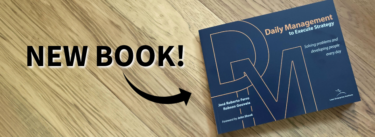Well let’s start with the good news. In my experience, non-manufacturing companies gain much more from lean than manufacturing companies do. I can’t give you any scientific proof of this but I have participated in lean turnarounds in hospitals and service companies and have always found the waste to be much bigger in these type of organizations. In some ways there is more opportunity: manufacturing companies are constantly looking for ways to become more efficient, while the focus in non-manufacturing companies is oftentimes in other areas like new products or services. They don’t prioritize eliminating waste as a starting point and have more room to run this regard. In addition, while it is easy to see the work and identify the problems on the manufacturing floor, an office environment can be trickier when it comes to following the actual work that is taking place.
Both types of companies share something in common: they are nothing more than a group of people and a bunch of processes trying to deliver value to a set of customers. And lean principles apply to each. To become lean, every company must focus on removing the waste in their current processes in order to deliver more value to the customers. Every company or organization wants to be able to compete on their operational excellence, and removing the waste enables them to gain market share by competing on speed. Think of a bank that can turn around a loan application for a car or house in 1-2 days while the competition takes 3-4 weeks; or an insurance company that can underwrite a new policy in 5 days when the competition takes 40-50 days.
All companies need to understand that lean is all about people. You are trying to transform the people—who are the only asset you have that can appreciate over time. It’s management’s responsibility to make sure this happens. Easy to say but how do you do it? Once again the approach for manufacturing and non-manufacturing companies is the same.
All companies share something in common: they are nothing more than a group of people and a bunch of processes trying to deliver value to a set of customers. And lean principles apply to each.Start with a simple strategy that states the objective and defines the stretch goals that you think will define operational excellence for you. Things like customer service, quality, productivity, lead time, visual control, etc. These all need to be aspirational in nature and not just some small increment from your current state. You probably also need a growth objective like “double in size every three to four years.” Shoot for goals that once achieved will totally change the nature of your organization and its ability to compete. If the reaction to these goals is “you must be kidding, how will we ever do that”, then you are on the right track.
Next, establish a value stream organizational structure and deploy these operational excellence goals down to the value stream leaders. Have them report weekly on their progress toward these goals. This will get everyone in the organization working on a simple set of objectives that once achieved will set the company apart.
Next, teach your people how to see and remove the waste. Some brief upfront training on lean fundamentals will help, but don’t overdo it. The real learning comes from participating on kaizen teams and achieving big gains in a short (one week is pretty normal) time frame. Make sure the kaizen teams have a mix of salaried and hourly employees; and if everyone is salaried make sure there is a good mix of the value adders and the managers on a team. It is especially important to have senior management on 5-6 full-week kaizen teams per year so they can start to see and understand the amount of waste that exists. You will get many gains, but more importantly, there will be lots of learning. You want to become a learning company with a kaizen culture.
So where to begin? It will depend on the type of non-manufacturing company of course, but start with your biggest and most important process. For an insurance company, it may be underwriting, for a bank it could be processing loan applications or maybe a back office process where the bulk of your employees are. A hospital may want to attack the process, or lack of a process to improve bed turnover and/or patient outcomes, while a distributor may want to focus on inventory turnover and ease of service.
The next step is to lay out the process elements step by step, including very minor ones like “move to the next step on the third floor.” Use value stream mapping to give you a picture of not only the steps but the time it takes for each, as well as any waiting time. Any process can be broken down into three elements: value adding, non-value adding but necessary (perhaps complying with some state or federal regulation); or waste. In a 35 step process it is not uncommon to find that there are only 5 or 6 steps that actually add value. The value stream mapping will help you see this and remove the waste and of course greatly shorten the time that it takes to complete the task.
Once you have the value stream map laid out go out on the floor and observe the work as it occurs. Has the kaizen team timed the actual work step by step, including the time it takes to move it and the time it spends waiting? This should open your eyes. But to actually remove the waste you will have to improve the flow. And this might be a problem for you at first. For example, let’s say we are processing a loan application for a bank and the work takes seven different people on four different floors in five different departments. Each department is made up of so called experts in whatever step they are responsible for. It takes three weeks for the loan application on average to get through all the steps. Each department is its own fiefdom and will fight really hard to keep the structure as it is. What to do?
Well, say you take the seven experts and just sit them around a big table. When the first mail delivery arrives at 8:30 am you dump the loan applications next to the person at step one, and after completing his/her work, step one passes the application to the person right next to him/her in step two, and so on till the application is completed. It will probably only take a few minutes for each application now vs. the former three weeks. If there is a second mail delivery at say 12:30, the team can then process those in the same way. All of a sudden the three week lead time is down to one day.
Once you have improved the biggest process then go on to the next one and keep going. Run lots of kaizen teams. Get everyone on a team as soon as possible. Break down the fiefdoms and let the work flow. You will be amazed at both the gains and how good everyone feels about making the improvements and making their work easier.
You may find a little resistance at first. For whatever reason I have found employees and management in non-manufacturing companies to be much more resistant to change, even small changes, than manufacturing companies. So you may have to show a little patience, but the gains will be so big they should overwhelm most resistance. For example, our loan processing example above where the time dropped from three weeks to one day is a little hard to ignore in terms of the competitive advantage it delivers, not to mention the cost reduction. So get out there, be bold, and you won’t be disappointed.





